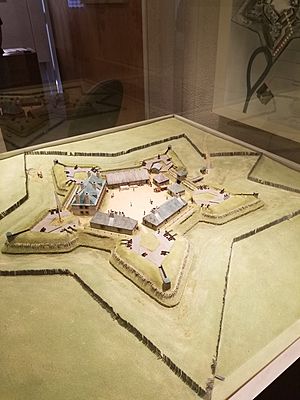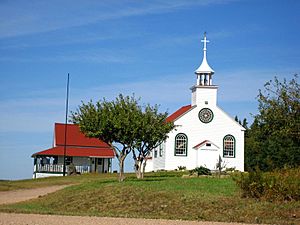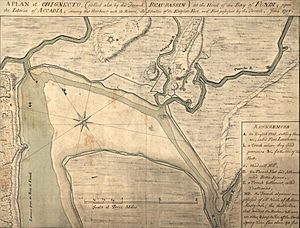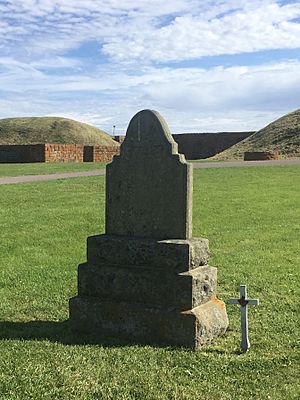Battle of Fort Cumberland (1776) facts for kids
Quick facts for kids Battle of Fort Cumberland |
|||||||
|---|---|---|---|---|---|---|---|
| Part of the American Revolution | |||||||
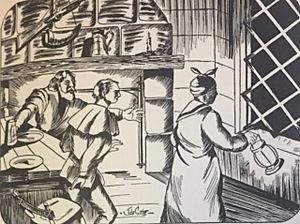 Commander Joseph Goreham, Battle of Fort Cumberland, 1776 |
|||||||
|
|||||||
| Belligerents | |||||||
| Commanders and leaders | |||||||
| Jonathan Eddy Benoni Danks |
Joseph Goreham John Eagleson Thomas Dixson |
||||||
| Strength | |||||||
| 400+ militia | 200 militia (Fencibles) | ||||||
| Casualties and losses | |||||||
| "some" killed 5 captured (1 died of wounds) |
13 killed Unknown wounded 56 captured |
||||||
The Battle of Fort Cumberland was an important event during the American Revolutionary War in late 1776. It is also known as the Eddy Rebellion. This battle was an attempt by a small group of American supporters, led by Jonathan Eddy, to bring the war to Nova Scotia.
Eddy's group, made up of about 400 to 500 volunteers and Native American allies, tried to capture Fort Cumberland. This fort was in central Nova Scotia, near where New Brunswick is today. The attack happened in November 1776.
The fort was defended by the Royal Fencible American Regiment, led by Commander Joseph Goreham. His soldiers successfully fought off several attacks. The siege ended when British reinforcements arrived on November 29. They drove Eddy's forces away.
After the battle, homes and farms of people who supported Eddy were destroyed. Many Patriot supporters had to leave the area. The British victory at Fort Cumberland helped keep Nova Scotia loyal to Britain throughout the war.
Contents
Why Was Fort Cumberland Important?
In the early days of the American Revolutionary War, Nova Scotia was not well protected. People worried that Americans might try to start an uprising there. Even though some soldiers arrived in Halifax, the areas away from the city were lightly guarded.
Fort Cumberland was located on the Isthmus of Chignecto. This narrow strip of land connects mainland Nova Scotia with New Brunswick. This area was very important in earlier wars between the French and British.
The French first built the fort in 1750 and called it Fort Beauséjour. The British captured it in 1755 during the Battle of Fort Beauséjour. After the Seven Years' War, the British didn't keep many soldiers there. By 1768, the fort was abandoned and in bad shape.
Preparing Fort Cumberland for Battle
In the summer of 1776, Colonel Joseph Goreham arrived at Fort Cumberland. He was a veteran of the French and Indian War. He brought about 200 Loyalist soldiers from the RFA. Their job was to fix up the fort and make it ready for defense.
However, Goreham and his men didn't have enough supplies. They lacked food, uniforms, and other important items. Also, many local people supported the American Patriots. They refused to help repair the fort. Some even tried to convince Goreham's soldiers to join the Patriot side.
Who Was Jonathan Eddy?
Jonathan Eddy was born in Massachusetts but lived in Cumberland County, Nova Scotia. He and John Allan were key leaders of the Patriot movement in the area. This region was one of several places in Nova Scotia where people supported the American cause.
Other areas with Patriot activity included Maugerville (in present-day New Brunswick) and Cobequid. Patriots in these communities kept in touch with each other. They also tried to get local Native American groups, like the Passamaquoddy, Maliseet, and Mi'kmaq, to join their side.
Eddy Seeks Support for the Rebellion
Eddy believed that with help from the Thirteen Colonies, he could challenge the British government in Nova Scotia. In early 1776, he went to Massachusetts to ask for military support. Meanwhile, John Allan worked to gather support within Nova Scotia.
Allan's efforts became harder when Colonel Goreham and his troops arrived to rebuild Fort Cumberland. Goreham's soldiers were successful in stopping Patriot activities in the Cumberland area. This forced the Patriot movement to go underground.
Eddy returned to Massachusetts in August 1776. The Second Continental Congress and George Washington did not want to officially support military actions in Nova Scotia. However, Eddy convinced the Massachusetts Provincial Congress to provide some supplies. These included muskets, ammunition, and gunpowder. He was also allowed to recruit soldiers in Maine.
Gathering Forces for the Attack

Eddy left Boston in September and sailed to Machias, where he recruited about 20 men. On October 13, they sailed towards Passamaquoddy Bay. Eddy met John Allan, who tried to convince him to wait. Allan told Eddy that the Mi'kmaq people would not help him.
The council in Machias also sent a letter urging Eddy to give up his plan. But Eddy decided to continue. He left Passamaquoddy Bay with nine Passamaquoddy recruits.
From there, Eddy sailed up the Saint John River to Maugerville. He recruited 27 more men there. He then went to Aukpaque, a Maliseet settlement. The main Maliseet chief, Pierre Tomah, was not interested in fighting.
However, Eddy convinced Ambroise St. Aubin, another Maliseet leader, and 15 men to join. They agreed to join if the Maugerville community supported their families. Eddy was also disappointed that no local Acadians joined, even though he had been promised their help.
The Attack Begins
With about 72 men, Eddy sailed up the Bay of Fundy to Shepody Outpost. On October 25, Eddy's men captured a patrol of Goreham's soldiers there. They killed one and wounded another. The prisoners were sent back to Machias.
Eddy continued to Memramcook, where about two dozen local Acadians joined him. This made his force larger. He then marched to Sackville, where more settlers joined. By Eddy's count, his force grew to about 180 men.
Colonel Goreham at Fort Cumberland finally learned about Eddy's actions on November 4. He increased the guard at the fort. However, he did not immediately send word to Halifax or Windsor. He was worried that Eddy's men might have blocked the roads.
Capturing the Supply Ship
On October 31, a British warship, the Juno, brought a supply ship called the Polly to Fort Cumberland. The Polly was full of supplies for the winter. Work began immediately to unload them. The Juno sailed away on November 3, leaving the Polly docked below the fort.
On November 6, Eddy's patrols got closer to the fort. Goreham knew Eddy's force was near. But he did not take extra steps to protect the Polly. That evening, 30 of Eddy's men surprised the guards on the Polly. They captured 13 prisoners and seized the ship.
The next morning, Goreham sent about 30 men to the dock. Eddy's men captured them as they arrived, because they didn't know the ship was taken. The Polly was then sailed to Fort Lawrence, where the supplies were unloaded. Goreham fired cannons at the ship, but it was too late.
The Siege of Fort Cumberland
Goreham realized his situation was serious. Nearly a quarter of his soldiers (over 60 men) had been captured. He also lost important fuel and supplies from the Polly. The fort's defenses were weak, with a quickly built fence and only three working cannons.
The fort had 176 soldiers, including officers. Over the next few days, local militia arrived, bringing the total to about 200. However, some of these men were sick and couldn't fight. Goreham tried to send messages for help on November 7 and 8, but his messengers couldn't get through Eddy's forces.
On November 8, Eddy was joined by about 200 more men from Cobequid and Pictou. He felt ready to attack on November 10. Eddy sent a letter demanding that Goreham surrender. Goreham refused and told Eddy to surrender instead.
British Reinforcements Arrive
On November 11, authorities outside the area learned of Eddy's actions. News reached Halifax, and Lieutenant Governor Marriot Arbuthnot sent orders for ships to bring troops to help.
A British warship, HMS Vulture, arrived at Windsor. It picked up some marines and Fencible soldiers.
Eddy's rebels did not have cannons. So, they tried to storm the fort on the night of November 12. They used a trick to try and draw Goreham's soldiers away from weak points. But Goreham was experienced and saw through the trick. He fought off the attack. One of Eddy's Native American warriors almost opened a gate inside the fort but was stopped.
After this failed attack, Eddy lost some control of his forces. A council of leaders formed against him. They ordered more night attacks on November 22 and 23. These attacks managed to capture and burn some buildings. But Goreham held his ground, and the attackers were pushed back again.
On November 27, HMS Vulture arrived. Instead of retreating, Eddy's rebels increased their guard. Goreham, knowing the size of Eddy's force, planned a surprise attack. Early on November 29, Major Thomas Batt led 150 men from the Vulture and the Royal Fencible Americans. They scattered Eddy's men, killing and wounding several. The British lost two dead and three wounded.
What Happened Next?
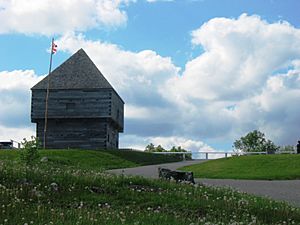
Major Batt's men chased Eddy's forces. But bad weather and a lack of proper shoes made him stop the pursuit. Eddy's forces scattered. Many retreated overland to Maugerville. Some of the men from Massachusetts took over two months to get back to Machias.
Homes and farms of people who supported the rebels were burned as punishment. However, British authorities were kind to the captured rebels. Richard John Uniacke, for example, later became the Attorney General of Nova Scotia. Goreham offered a pardon to those who would give up their weapons. More than 100 local people accepted this offer.
The British victory at Fort Cumberland made their control stronger in Nova Scotia. It forced Patriot supporters like Allan and Eddy out of the province. It also made those who remained more loyal to the British Crown. Some small unrest continued during the war, but no other large military threats happened.
The Battle of Fort Cumberland was not well-known in histories from the 1800s. The involvement of local people, including Native Americans, Acadians, and English speakers, was often not mentioned. Today, the site of Fort Cumberland is a National Historic Site of Canada. It is managed by Parks Canada.
See also


